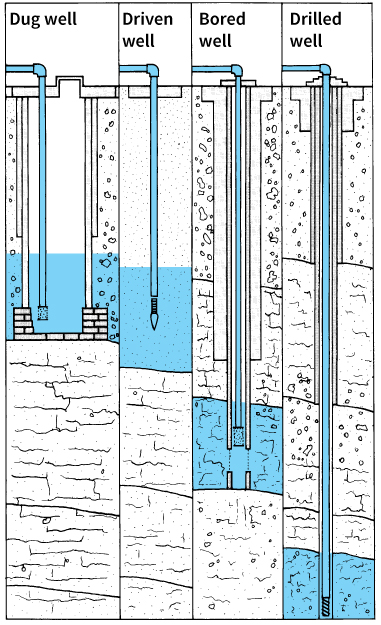Well is a hole in Earth from which a fluid is withdrawn. Water wells are the most common type. Oil and natural gas wells are also common. Mining companies also pump steam and hot water down wells to remove salt and sulfur from deep in the ground.

Water wells.
The underground water that flows into wells is called ground water (see Ground water ). Most of this water comes from rain that soaks into the ground and slowly moves down to the ground water reservoir, an area of soil and rock saturated with water. The top of this zone is the water table, the level at which water stands in a well that is not being pumped.
In damp places, the water table may lie just below the surface. It is easily reached by digging. A dug well is usually lined with bricks, stone, or porous concrete to keep the sides from caving in. In drier places, the water table may be hundreds of feet or meters down. It may be necessary to drill the well and sink pipes. Power-driven pumps usually draw the water out of deep wells.
In some areas, underground water moving down from the slopes of hills and mountains becomes trapped under watertight layers of clay or shale. Wells drilled through these layers in valleys and plains run into water under pressure. Such wells are called flowing artesian wells. See Artesian well .
Many people depend on wells for their water supply, especially in rural areas. Underground water is usually pure, because soil makes a good filter. This water generally contains dissolved minerals. A well that taps water with a high mineral content is called a mineral well.
Water wells should be located so that they do not collect poisons or disease germs. A well should be at least 100 feet (30 meters) from a cesspool and should never be located so that sewage drains toward it. Water from a well sunk through limestone may be dangerous because water runs through crevices and caves in limestone without being filtered. It is also important that surface water does not drain into a well.
Oil and natural gas wells.
Oil and natural gas are lighter than water. Because of this, they would normally float upward and escape from the ground. But oil and gas become trapped beneath thick beds of rock in areas called reservoirs. Wells penetrate deep into Earth to reach these reservoirs and bring the oil and gas to the surface. Wildcat wells are drilled in search of reservoirs. A production well is drilled into a proven field.
Drilling oil and gas wells is a highly developed science. Workers who drill deep wells must have many years of training and experience. A deep oil well may cost several million dollars. See Gas (From well to user) ; Petroleum (Drilling for petroleum) .
Locating wells
also requires a high degree of training. Geologists and engineers must be able to find where large amounts of oil or water lie. They then determine at what rate they can take these materials out of the ground. They also decide how much they can remove without damaging the natural resources.
Today, scientists and engineers use seismographs and other equipment to locate underground deposits (see Seismograph ). But some people attempt magic to locate water with a forked branch called a divining rod. The user grips the two forks firmly with the main stem held outward. The stem will move up or down unless the holder exerts effort to prevent it. A slight relaxation will cause the stem to point downward. Some people claim that the rod then points to water. People using a divining rod may succeed in locating water, but only because they have a common-sense idea of where water is usually found.
